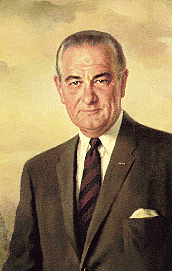 Lyndon B. Johnson
Lyndon B. Johnson
"A Great Society" for the American people and their fellow men
elsewhere was the vision of Lyndon B. Johnson. In his first years of office he
obtained passage of one of the most extensive legislative programs in the Nation's
history. Maintaining collective security, he carried on the rapidly growing
struggle to restrain Communist encroachment in Viet Nam.
Johnson was born on August 27, 1908, in central Texas, not far from Johnson City,
which his family had helped settle. He felt the pinch of rural poverty as he
grew up, working his way through Southwest Texas State Teachers College; he learned
compassion for the poverty of others when he taught students of Mexican descent.
In 1937 he campaigned successfully for the House of Representatives on a New
Deal platform, effectively aided by his wife, the former Claudia "Lady Bird"
Taylor, whom he had married in 1934.
During World War II he served briefly in the Navy as a lieutenant commander,
winning a Silver Star in the South Pacific. After six terms in the House, Johnson
was elected to the Senate in 1948. In 1953, he became the youngest Minority
Leader in Senate history, and the following year, when the Democrats won control,
Majority Leader. With rare skill he obtained passage of a number of key Eisenhower
measures.
In the 1960 campaign, Johnson, as John F. Kennedy's running mate, was elected Vice
President. On November 22, 1963, when Kennedy was assassinated, Johnson was
sworn in as President.
First he obtained enactment of the measures President Kennedy had been urging at
the time of his death--a new civil rights bill and a tax cut. Next he
urged the Nation "to build a great society, a place where the
meaning of man's life matches the marvels of man's labor." In 1964, Johnson won the
Presidency with 61 percent of the vote and had the widest popular margin in American
history--more than 15,000,000 votes.
The Great Society program became Johnson's agenda for Congress in January 1965:
aid to education, attack on disease, Medicare, urban renewal, beautification,
conservation, development of depressed regions, a wide-scale fight against poverty,
control and prevention of crime and delinquency, removal of obstacles to the right
to vote. Congress, at times augmenting or amending, rapidly enacted Johnson's
recommendations. Millions of elderly people found succor through the 1965
Medicare amendment to the Social Security Act.
Under Johnson, the country made spectacular explorations of space in a program
he had championed since its start. When three astronauts successfully orbited the
moon in December 1968, Johnson congratulated them: "You've taken ... all of us, all
over the world, into a new era. . . . "
Nevertheless, two overriding crises had been gaining momentum since 1965. Despite
the beginning of new antipoverty and anti-discrimination programs, unrest and
rioting in black ghettos troubled the Nation. President Johnson steadily exerted
his influence against segregation and on behalf of law and order, but there was no
early solution.
The other crisis arose from Viet Nam. Despite Johnson's efforts to end Communist
aggression and achieve a settlement, fighting continued. Controversy over the war
had become acute by the end of March 1968, when he limited the bombing of North
Viet Nam in order to initiate negotiations. At the same time, he startled the
world by withdrawing as a candidate for re-election so that he might devote his
full efforts, unimpeded by politics, to the quest for peace.
When he left office, peace talks were under way; he did not live to see them
successful, but died suddenly of a heart attack at his Texas ranch on
January 22, 1973.